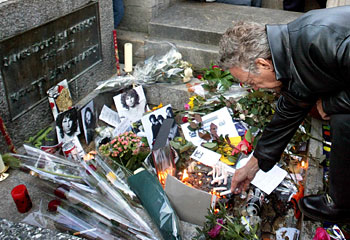Parisian tribute is dead famous
JENNY Stevens finds a faded glory among the crumbling relics of a Paris cemetery where giggling schoolgirls, maps in hand, dash to find the graves of dead celebrities.

PERE Lachaise doesn't feel dead. Gaggles of giggling schoolgirls, maps in hand, dash from one street to another to find a dead celebrity.
Sober tour guides in their tweeds usher the living from tomb to tomb, giving little discourses on the dead within.
Couples seeking quieter corners stroll hand in hand down sunlit avenues, and elderly women busily clean and tidy family chapels.
Pere Lachaise cemetery in the 20th arrondissement of Paris, named after Louis XIV's Jesuit confessor is, like its inhabitants, a crumbling relic – but it's anything but dead.
Trains disgorge the curious by the hundreds at the stations nearby; map sellers set up their stalls outside the walls, flogging mass-produced cemetery maps for one or two euros, and touts hang around the avenues inside the cemetery waiting to guide lost tourists to the dead famous.
One of its most noted residents, Jim Morrison, ended his drug-fuelled rock-star life in a blaze of publicity in 1971 Paris.
But if The Doors' lead singer was looking for nirvana in death, he hasn't found it here. His sad little concrete tomb with its dirt covering, plastic and wilted flowers, cigarette butts, faded pictures and love letters ripped from cheap notepads, is in danger of being trampled to bits.
In life, Morrison gave life and the establishment the finger; in death, he's in danger of being famous for being famous. As we picked our way back to the access road, gingerly stepping around the tombs that sprout around Morrison's narrow plot, a confused Spanish schoolgirl, camera in hand, asked in fractured English: "Where is the tomb of Kurt Cobain?"
The importance of being Oscar Wilde, playwright and wit, is gloriously exposed on his large memorial by the American sculptor Jacob Epstein.
The large block displays a winged, naked and emasculated demon angel (the prominent genitals which once shocked society have been souvenired) carved in relief, and covered with hundreds of lipstick kisses and little messages such as "You are my star" and "Grazie".
This is despite attempts by the cemetery governors who have erected a sign imploring visitors to "respect the memory of Oscar Wilde and do not defile this tomb". There is even a note saying the tomb is an official historic monument – surely something about which Oscar Wilde would have had a caustic remark or three.
After all, this is the wit whose famous last words in 1900 were about the awful wallpaper in his cheap Paris hotel room, along the lines of, "One of us has to go."
Actors Yves Montand and Simone Signoret – lovers in life and together in death – are buried in an unremarkable grave near Wilde, but even they weren't allowed to rest in peace. After Montand's death in 1991, his body was exhumed to settle a paternity dispute.
The "Little Sparrow", Edith Piaf, always attracts a crowd to her elegant black marble tomb on a sunny slope. A fan has taped a plastic-covered portrait of the chanteuse on the marble, with a little plaque reading: "Gentille papillon, va lui dire que je l'aime" (roughly, "Beautiful butterfly, could you say to her that I love her.") Fresh flowers fill the urn embossed with the gold letters EP, and pretty flowering plants sprout from planter boxes and pot plants.
Further down the hill, on a road inside the outer wall, are memorials to the heroes of the Occupation during World War II and the victims of the Holocaust. These are monuments to the heroes and martyrs of the Resistance and those who perished in the death camps.
As if to mitigate the horror they represent, they are surrounded by grass, peaceful walkways, manicured gardens and dappled shade.
This is in stark contrast to the cemetery's older sections, where gnarled trees sprout from graves and voracious roots cause the stones to rise and crack, as if the dead are tossing and turning in restless repose.
The cemetery's residents are a who's who of the arts and letters: Guillaume Apollinaire, Balzac, Bellini, Bizet, Sarah Bernhardt, Maria Callas, Chopin, Colette, Jacques Louis David, Eugene Delacroix, Isadora Duncan, Modigliani, Moliere, Camille Pisarro, Marcel Proust, Rossini, Gertrude Stein.
Then there's the star-crossed medieval lovers, Heloise and Abelard, who were reinterred
at the cemetery for publicity purposes soon after it opened, and have a fine monument near the main entrance.
But life still exists in this city of the dead: owls, blackbirds and feral cats eke out an existence, living off rodents and handouts; old men sit and dream their dreams on benches in the sun; elderly women find solace in the shaded avenues, and lovers find inspiration in the verses that others have left behind.
The writer flew courtesy of Scandinavian Airlines.
The Sunday Telegraph



